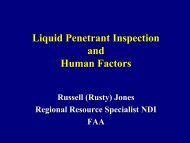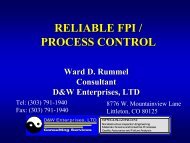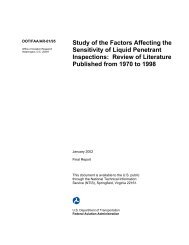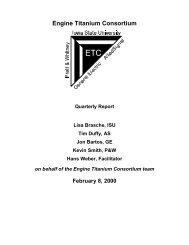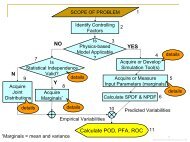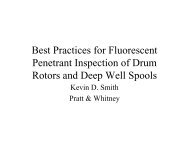Engine Titanium Consortium - Center for Nondestructive Evaluation ...
Engine Titanium Consortium - Center for Nondestructive Evaluation ...
Engine Titanium Consortium - Center for Nondestructive Evaluation ...
Create successful ePaper yourself
Turn your PDF publications into a flip-book with our unique Google optimized e-Paper software.
aluminum oxide blasting is concealing the tighter cracks more so than the open cracks. There<strong>for</strong>e<br />
the crack morphology is being considered in interpretation of the results.<br />
Some of the preliminary observations or conclusions include:<br />
• Vapor degreasing and aqueous cleaning both appear to be effective <strong>for</strong> removing oil.<br />
• Alkaline derust is not effective on oxidation/scale, or soot on Ti-6-4. Short soak, high or low<br />
concentrations do not effectively remove penetrating oil in Ti-6-4. Alkaline residue may reduce<br />
fluorescent penetrant brightness.<br />
• Alkaline gel was not an effective cleaning on either Ti-6-4 or INCO 718.<br />
• Wet glass-beading lead to loss of 4 of 6 cracks and significant brightness reductions in the<br />
other two cracks.<br />
• Aluminum oxide 500 mesh grit may be more suitable <strong>for</strong> critical rotating parts. Surface damage<br />
appears to occur <strong>for</strong> 240 and 320 mesh grit sizes.<br />
UVA<br />
Oct<br />
BL<br />
00-067<br />
UVA<br />
Oxidat.<br />
& scale<br />
An example of the data summaries that are being generated is shown above <strong>for</strong> sample 01-037.<br />
The in<strong>for</strong>mation includes the original optical micrograph <strong>for</strong> the sample, three UVA indications taken<br />
at different times and under different conditions at Delta and the optical micrograph after<br />
processing. This particular sample underwent walnut shell media blast which has been coded as<br />
the “B6” method. The BT values are brightness readings. Note that <strong>for</strong> this sample the brightness<br />
decreased from the baseline run after use of the walnut shell blast. However, subsequent<br />
processing through ultrasonic agitation in an acetone bath returned the brightness to levels near the<br />
original baseline. This indicates that some media may have remained in the crack immediately<br />
after blasting which was removed by the subsequent “fluid processing”. Consideration is being<br />
given to recommending that a water wash step be added after all mechanical blasting operations<br />
used to clean parts.<br />
Quarterly Report – January 1, 2002 –March 31, 2002<br />
print date/time: 6/6/2002 - 8:39 AM – Page 82



